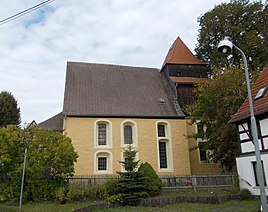Clodra
|
Clodra
City of Berga / Elster
Coordinates: 50 ° 45 ′ 31 ″ N , 12 ° 7 ′ 6 ″ E
|
|
|---|---|
| Height : | 303 m above sea level NN |
| Residents : | 260 |
| Incorporation : | March 8, 1994 |
| Postal code : | 07980 |
| Area code : | 036623 |
|
Hope Church Clodra
|
|
Clodra is a district of Berga / Elster in the Greiz district in Thuringia .
location
The place Clodra is twelve kilometers (as the crow flies) north of the district town of Greiz in the Bergaer Elstertal, in the side valley of the Harnbach about 100 m above the level of the Elstertal. To the west of the village, the federal highway 175 runs from Berga to Weida with a connection to the federal highway 92 , while the railway line from Gera to Greiz runs in the valley of the White Elster.
history
A cut Neolithic flint ax came to light during construction work in 1908, and several pots (or urns) with ashes are said to have been found in the garden of the manor as early as 1811. The village complex, which was created in the High Middle Ages by the influx of settlers, developed the type of street village as a settlement structure, which extends between the church and the manor with ponds. The place was first mentioned in 1260 as Cloderawe and 1281 as Kloderowe. The terms come from Slavic or Sorbian and are called place of the woodcutters.
As the oldest bearer of the name, Friedrich von Clodra appeared in 1287 as provost of the Premonstratensian monastery in Mildenfurth . The castle complex of Clodra, which was destroyed by an incursion by Bohemian mercenaries, is testified by a legend, structural remains of this castle are no longer verifiable. Through the Saxon Elector Christian I , Clodra came into the feudal possession of the von Wolfersdorf family on Waltersdorf in 1586.
The Cronschwitz Monastery received interest income from Clodra from donation contracts and for so-called Seelgerät .
The Clodraer Church - a late Romanesque choir tower church, was the parish church for the neighboring towns of Zickra and Dittersdorf even before the Reformation was introduced . The church building was set on fire during an attack on the village in 1633 and remained as a fire ruin until the economic consolidation of the place after the Thirty Years' War. The reconstruction was largely completed in 1658, the pulpit was not donated until 1764. Inside the church there are tombstones of the von Zehmen family as patron saints.
The clodr mill is located on the banks of the White Elster and was first mentioned in 1533. There is a bridge over the Weisse Elster nearby. The mill and bridge were damaged in the flood in June 2013.
Moritz Bastian von Zehmen acquired the manor in 1620, he was temporarily superintendent of the electoral rafts and trees. The fortified Clodra manor, which still appears defensive today and is equipped with the remains of a surrounding wall and tower, was previously owned by a knight Hans Adam Metzsch. The grandson Hans Bastian II von Zehmen spent his childhood here and had the burnt-out church repaired at his own expense in 1658. He set up the "Fabian Sebastian Foundation" for the needy, from whose interest until 1945 socially disadvantaged people received a donation. Hans Bastian II. Von Zehmen was appointed to the Saxon-Naumburg Secret Council, he was a deputy at the state parliaments in Dresden and served Duke Moritz zu Sachsen-Zeitz and Friedrich August I ( August the Strong ). His son Moritz Christoph von Zehmen built a new mansion in Clodra in 1751. The last owner from the von Zehmen family was Wilhelm von Zehmen . He sold it to a Major von Falkenstein in 1785. Some of the Clodra fron farmers of the von Wolfersdorf family on Waltersdorf remained committed to the manor in Waltersdorf .
According to statistical surveys from 1905, the place Clodra covered a total of 431 hectares with its block and manor block fields . In 1953 the LPG was founded and Clodra became the first fully cooperative village in the Greiz district.
The incorporation of the neighboring town of Dittersdorf was completed in 1974.
Attractions
Personalities
- Hans Bastian II. Von Zehmen (1629–1702), Electoral Saxon Secret Council, Ducal Judicial Council and deputy to the Dresden state parliament, grew up in Clodra, among other places.
- Christian Wilhelm Schweitzer (1781–1856) - lawyer and politician who spent his retirement in Clodra
Individual evidence
- ↑ a b City of Berga / Elster: districts. Retrieved May 27, 2017 .
- ↑ G. Voss: District Court District Weida (= architectural and art monuments of Thuringia) - Grand Duchy of Saxony-Weimar-Eisenach. Booklet 25. Fischer, Jena 1897 - section Clodra (edited by Rittmeister von Zehmen) pp. 263–264
- ↑ Dr. Frank Reinhold lecture on the village church on August 30, 2011
literature
- Hanns-Moritz von Zehmen: Genealogical news about the Meissen nobility of Zehmen, 1206 to 1906. Wilhelm Baensch, Dresden 1906
- Henriette Joseph, Haik Thomas Poroda: The northern Vogtland around Greiz , Landscapes in Germany, Volume 68, Böhlau Verlag GmbH & Cie., Cologne, Weimar, Vienna 2006, ISBN 978-3-412-09003-6 , explanations on Clodra p. 140-143
- Frank Reinhold: Family book Clodra near Berga / Elster with Dittersdorf and Zickra (district of Greiz), Thuringia, 1610 to 1798. Leipzig: AMF 2016 (= Central German local family books of AMF 97)


